Go结构体的内存布局
承蒙大家厚爱,我的《Go语言之路》的纸质版图书已经上架京东,有需要的朋友请点击 此链接 购买。
结构体的内存布局
结构体大小
结构体是占用一块连续的内存,一个结构体变量的大小是由结构体中的字段决定。
type Foo struct {
A int8 // 1
B int8 // 1
C int8 // 1
}
var f Foo
fmt.Println(unsafe.Sizeof(f)) // 3
内存对齐
但是结构体的大小又不完全由结构体的字段决定,例如:
type Bar struct {
x int32 // 4
y *Foo // 8
z bool // 1
}
var b1 Bar
fmt.Println(unsafe.Sizeof(b1)) // 24
有的同学可能会认为结构体变量b1的内存布局如下图所示,那么问题来了,结构体变量b1的大小怎么会是24呢?
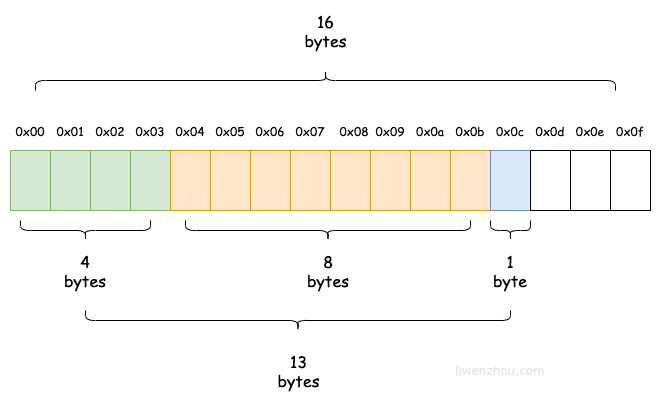
很显然结构体变量b1的内存布局和上图中的并不一致,实际上的布局应该如下图所示,灰色虚线的部分就是内存对齐时的填充(padding)部分。

Go 在编译的时候会按照一定的规则自动进行内存对齐。之所以这么设计是为了减少 CPU 访问内存的次数,加大 CPU 访问内存的吞吐量。如果不进行内存对齐的话,很可能就会增加CPU访问内存的次数。例如下图中CPU想要获取b1.y字段的值可能就需要两次总线周期。
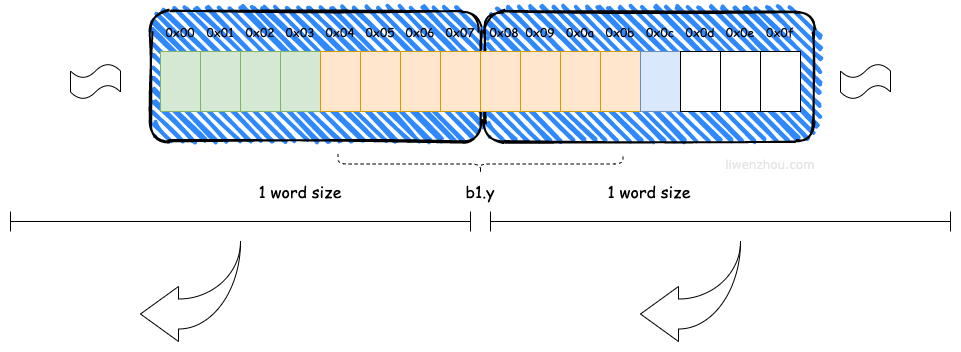
因为 CPU 访问内存时,并不是逐个字节访问,而是以字(word)为单位访问。比如 64位CPU的字长(word size)为8bytes,那么CPU访问内存的单位也是8字节,每次加载的内存数据也是固定的若干字长,如8words(64bytes)、16words(128bytes)等。
对齐保证
我们上面已经知道了可以通过内置unsafe包的Sizeof函数来获取一个变量的大小,此外我们还可以通过内置unsafe包的Alignof函数来获取一个变量的对齐系数,例如:
// 结构体变量b1的对齐系数
fmt.Println(unsafe.Alignof(b1)) // 8
// b1每一个字段的对齐系数
fmt.Println(unsafe.Alignof(b1.x)) // 4:表示此字段须按4的倍数对齐
fmt.Println(unsafe.Alignof(b1.y)) // 8:表示此字段须按8的倍数对齐
fmt.Println(unsafe.Alignof(b1.z)) // 1:表示此字段须按1的倍数对齐
unsafe.Alignof()的规则如下:
- 对于任意类型的变量 x ,
unsafe.Alignof(x)至少为 1。 - 对于 struct 类型的变量 x,计算 x 每一个字段 f 的
unsafe.Alignof(x.f),unsafe.Alignof(x)等于其中的最大值。 - 对于 array 类型的变量 x,
unsafe.Alignof(x)等于构成数组的元素类型的对齐倍数。
在了解了上面的规则之后,我们就可以通过调整结构体 Bar 中字段的顺序来减少其大小:
type Bar2 struct {
x int32 // 4
z bool // 1
y *Foo // 8
}
var b2 Bar2
fmt.Println(unsafe.Sizeof(b2)) // 16
此时结构体 Bar2 变量的内存布局示意图如下:
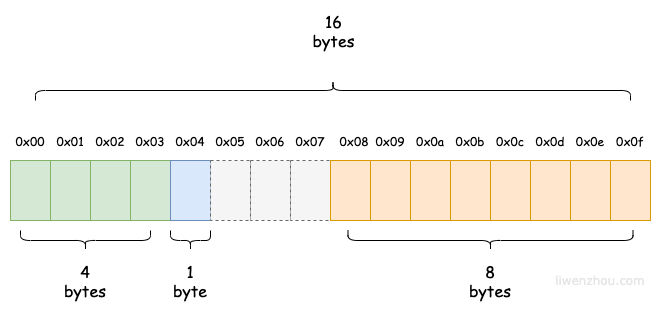
或者将字段顺序调整为以下顺序。
type Bar3 struct {
z bool // 1
x int32 // 4
y *Foo // 8
}
var b3 Bar3
fmt.Println(unsafe.Sizeof(b3)) // 16
此时结构体 Bar3 变量的内存布局示意图如下:
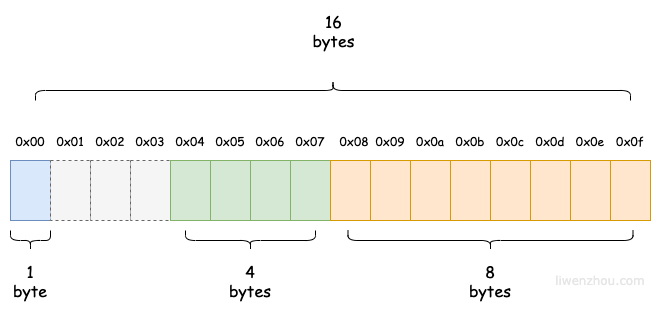
总结一下:在了解了Go的内存对齐规则之后,我们在日常的编码过程中,完全可以通过合理地调整结构体的字段顺序,从而优化结构体的大小。
结构体内存布局的特殊场景
除了上述利用内存对齐规则调整字段顺序优化结构体内存布局外,关于Go语言中结构体的内存布局还存在以下几种相对特殊的场景需要注意。
空结构体字段对齐
首先我们需要了解的一个前提是:如果结构或数组类型不包含大小大于零的字段(或元素),则其大小为0。两个不同的0大小变量在内存中可能有相同的地址。
由于空结构体struct{}的大小为 0,所以当一个结构体中包含空结构体类型的字段时,通常不需要进行内存对齐。例如:
type Demo1 struct {
m struct{} // 0
n int8 // 1
}
var d1 Demo1
fmt.Println(unsafe.Sizeof(d1)) // 1
但是当空结构体类型作为结构体的最后一个字段时,如果有指向该字段的指针,那么就会返回该结构体之外的地址。为了避免内存泄露会额外进行一次内存对齐。
type Demo2 struct {
n int8 // 1
m struct{} // 0
}
var d2 Demo2
fmt.Println(unsafe.Sizeof(d2)) // 2
示意图:
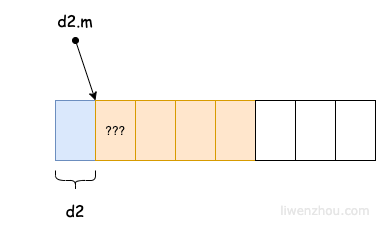
在实际编程中通过灵活应用空结构体大小为0的特性能够帮助我们节省很多不必要的内存开销。
例如,我们可以使用空结构体作为map的值来实现一个类似 Set 的数据结构。
var set map[int]struct{}
我们还可以使用空结构体作为通知类channel的元素,例如Go源码src/cmd/internal/base/signal.go中。
// src/cmd/internal/base/signal.go
// Interrupted is closed when the go command receives an interrupt signal.
var Interrupted = make(chan struct{})
以及 src/net/pipe.go中都有类似的使用示例。
// src/net/pipe.go
// pipeDeadline is an abstraction for handling timeouts.
type pipeDeadline struct {
mu sync.Mutex // Guards timer and cancel
timer *time.Timer
cancel chan struct{} // Must be non-nil
}
原子操作在32位平台要求强制内存对齐
在 x86 平台上原子操作需要强制内存对齐是因为在 32bit 平台下进行 64bit 原子操作要求必须 8 字节对齐,否则程序会 panic,下面是Go源码src/atomic/doc.go中的说明。
// src/atomic/doc.go
// BUG(rsc): On 386, the 64-bit functions use instructions unavailable before the Pentium MMX.
//
// On non-Linux ARM, the 64-bit functions use instructions unavailable before the ARMv6k core.
//
// On ARM, 386, and 32-bit MIPS, it is the caller's responsibility
// to arrange for 64-bit alignment of 64-bit words accessed atomically.
// The first word in a variable or in an allocated struct, array, or slice can
// be relied upon to be 64-bit aligned.
这里可以参照groupcache库中的实际应用,示例代码如下。
type Group struct {
name string
getter Getter
peersOnce sync.Once
peers PeerPicker
cacheBytes int64 // limit for sum of mainCache and hotCache size
// mainCache is a cache of the keys for which this process
// (amongst its peers) is authoritative. That is, this cache
// contains keys which consistent hash on to this process's
// peer number.
mainCache cache
// hotCache contains keys/values for which this peer is not
// authoritative (otherwise they would be in mainCache), but
// are popular enough to warrant mirroring in this process to
// avoid going over the network to fetch from a peer. Having
// a hotCache avoids network hotspotting, where a peer's
// network card could become the bottleneck on a popular key.
// This cache is used sparingly to maximize the total number
// of key/value pairs that can be stored globally.
hotCache cache
// loadGroup ensures that each key is only fetched once
// (either locally or remotely), regardless of the number of
// concurrent callers.
loadGroup flightGroup
_ int32 // force Stats to be 8-byte aligned on 32-bit platforms
// Stats are statistics on the group.
Stats Stats
}
// ...
// Stats are per-group statistics.
type Stats struct {
Gets AtomicInt // any Get request, including from peers
CacheHits AtomicInt // either cache was good
PeerLoads AtomicInt // either remote load or remote cache hit (not an error)
PeerErrors AtomicInt
Loads AtomicInt // (gets - cacheHits)
LoadsDeduped AtomicInt // after singleflight
LocalLoads AtomicInt // total good local loads
LocalLoadErrs AtomicInt // total bad local loads
ServerRequests AtomicInt // gets that came over the network from peers
}
Group结构体中通过添加一个int32字段强制让Stats字段在32bit平台也是8字节对齐的。
fasle sharing
结构体内存对齐除了上面的场景外,在一些需要防止CacheLine伪共享的时候,也需要进行特殊的字段对齐。例如sync.Pool中就有这种设计:
type poolLocal struct {
poolLocalInternal
// Prevents false sharing on widespread platforms with
// 128 mod (cache line size) = 0 .
pad [128 - unsafe.Sizeof(poolLocalInternal{})%128]byte
}
结构体中的pad字段就是为了防止false sharing而设计的。
当不同的线程同时读写同一个cache line上不同数据时就可能发生false sharing。false sharing会导致多核处理器上严重的系统性能下降。具体的可以参考 伪共享(False Sharing)。
如注释所说这里之所以使用128字节进行内存对齐是为了兼容更多的平台。
hot path
hot path 是指执行非常频繁的指令序列。
在访问结构体的第一个字段时,我们可以直接使用结构体的指针来访问第一个字段(结构体变量的内存地址就是其第一个字段的内存地址)。
如果要访问结构体的其他字段,除了结构体指针外,还需要计算与第一个值的偏移(calculate offset)。在机器码中,偏移量是随指令传递的附加值,CPU 需要做一次偏移值与指针的加法运算,才能获取要访问的值的地址。因为访问第一个字段的机器代码更紧凑,速度更快。
下面的代码是标准库sync.Once中的使用示例,通过将常用字段放置在结构体的第一个位置上减少CPU要执行的指令数量,从而达到更快的访问效果。
// src/sync/once.go
// Once is an object that will perform exactly one action.
//
// A Once must not be copied after first use.
type Once struct {
// done indicates whether the action has been performed.
// It is first in the struct because it is used in the hot path.
// The hot path is inlined at every call site.
// Placing done first allows more compact instructions on some architectures (amd64/386),
// and fewer instructions (to calculate offset) on other architectures.
done uint32
m Mutex
}
参考链接:https://stackoverflow.com/questions/59174176/what-does-hot-path-mean-in-the-context-of-sync-once





